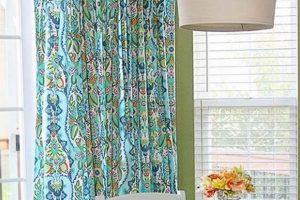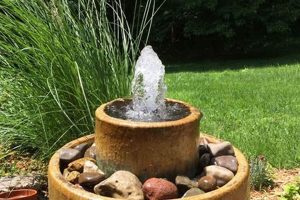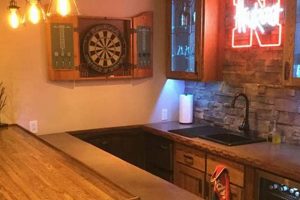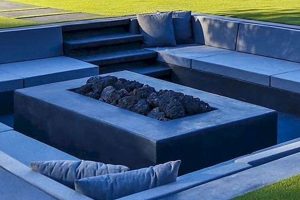Constructing a personalized water feature using natural stones presents a rewarding opportunity to enhance outdoor and indoor spaces. Such projects involve the careful selection and arrangement of rocks, combined with a recirculating water system, to create a visually appealing and aurally soothing element. These projects offer a means of incorporating natural aesthetics into residential and commercial settings.
The appeal of these handcrafted installations lies in their ability to transform environments into tranquil retreats. The gentle flow of water cascading over stone surfaces provides a calming auditory experience, masking unwanted noises and promoting relaxation. Historically, water features have been employed in gardens and landscapes across various cultures, signifying prosperity and serenity. Creating these features allows one to personalize their environment while benefiting from the psychological and aesthetic advantages associated with flowing water.
The following sections will delve into the crucial aspects of designing and building a personalized water element, from material selection and pump specifications to assembly techniques and safety considerations. Key areas covered include rock selection criteria, establishing a suitable water reservoir, and ensuring proper pump functionality for continuous water circulation.
Practical Considerations for Stone Water Feature Construction
The successful execution of a personalized stone water feature hinges on meticulous planning and adherence to specific construction principles. These guidelines address critical aspects of the build process, ensuring structural integrity, operational efficiency, and longevity.
Tip 1: Foundation Stability: Establish a solid, level base for the water feature. Uneven surfaces can lead to instability and potential collapse. Consider using a compacted gravel base topped with paving stones or a concrete pad for optimal support.
Tip 2: Reservoir Integrity: Select a durable, watertight reservoir to contain the recirculating water. Pre-formed pond liners or robust plastic containers are suitable options. Ensure the reservoir is adequately sized to accommodate the pump and rock structure.
Tip 3: Pump Selection: Choose a submersible pump with sufficient flow rate (gallons per hour) to create the desired water flow. The pump’s head height (maximum vertical distance water can be pumped) should exceed the height of the water feature.
Tip 4: Rock Placement: Strategically arrange the stones to create a visually appealing and functional watercourse. Securely position each stone to prevent shifting or toppling. Use construction adhesive designed for outdoor use to bond rocks if necessary.
Tip 5: Tubing and Connections: Utilize flexible tubing to connect the pump to the water outlet at the top of the feature. Ensure all connections are secure and watertight to prevent leaks. Conceal tubing discreetly within the rock structure.
Tip 6: Electrical Safety: Employ a Ground Fault Circuit Interrupter (GFCI) outlet to power the pump. This device protects against electrical shock in the event of a short circuit. Position the outlet in a weather-protected location.
Tip 7: Water Quality Management: Regularly inspect the water for algae growth or debris accumulation. Use a pond treatment to maintain water clarity and prevent pump clogging. Periodically drain and clean the reservoir.
These essential steps contribute to a stable, safe, and aesthetically pleasing water feature, providing long-term enjoyment. Consistent maintenance and careful execution are paramount for ensuring its lasting performance.
The following section explores common challenges encountered during construction and offers solutions for mitigating potential issues.
1. Rock Selection
The selection of rocks is paramount to the successful construction and aesthetic appeal of personalized water features. The type, size, shape, and texture of the rocks directly impact the visual character of the structure, influencing its integration with the surrounding environment. Furthermore, the chosen material affects the functional aspects, such as water flow dynamics and structural stability. Inferior rock selection can lead to premature degradation, instability, or an aesthetically discordant final product.
For instance, utilizing sedimentary rocks susceptible to erosion in a high-flow water feature can result in rapid weathering and disintegration, compromising both its visual appeal and the water’s clarity. Conversely, selecting dense, non-porous rocks, like granite or basalt, can provide enhanced durability and resistance to weathering. Rock shape dictates the water flow patterns; flat, layered stones create cascading waterfalls, while rounded stones promote a more gentle, meandering flow. Careful consideration of these factors is necessary to ensure the water feature functions optimally and maintains its aesthetic integrity over time. The incorrect implementation or rock selection can also impact the water pump that circulates the water; pump failure occurs due to debris and the rock selection not filtering the particles correctly.
In conclusion, rock selection is not merely an aesthetic consideration but a functional requirement influencing the durability, stability, and visual harmony of a water feature. Informed decision-making regarding rock type and characteristics is essential for achieving a successful and long-lasting creation. Neglecting these material considerations can lead to premature failure, increased maintenance, and a diminished aesthetic impact.
2. Pump Capacity
Pump capacity is a critical determinant in the operational efficacy and aesthetic realization of personalized water features. The selection of an appropriately sized pump is paramount for achieving the desired water flow, visual impact, and overall functionality of the project. Insufficient pump capacity results in underwhelming water features, while excessive capacity can lead to wasted energy and an unnatural, overpowering water display.
- Flow Rate and Water Feature Height
The flow rate, measured in gallons per hour (GPH), directly influences the height and volume of water that can be effectively circulated. A higher water feature necessitates a pump with a greater flow rate to overcome gravitational forces and deliver water to the desired elevation. For example, a three-tiered rock formation requires a pump with significantly more GPH than a simple, single-level cascade. Incorrect calculations lead to stagnant water or inadequate flow, undermining the visual appeal.
- Head Height and Pump Performance
Head height refers to the maximum vertical distance a pump can effectively lift water. It is essential to select a pump with a head height exceeding the vertical distance from the water reservoir to the highest poi
nt of the water feature. Failure to account for head height results in diminished pump performance and reduced water flow, negating the desired aesthetic and functional outcomes. Proper assessment ensures the pump operates within its optimal parameters. - Pond Volume and Turnover Rate
For water features incorporating a significant water reservoir or pond, the pump’s capacity should facilitate an appropriate turnover rate. Turnover rate refers to the frequency with which the entire volume of water is circulated through the pump and filtration system (if applicable). A faster turnover rate promotes cleaner water and inhibits algae growth, contributing to the longevity and health of the water feature. Inadequate turnover leads to stagnant water and increased maintenance requirements.
- Energy Consumption and Efficiency
Pump capacity impacts energy consumption, making energy efficiency a salient consideration. Oversized pumps consume more electricity than necessary, increasing operational costs and environmental impact. Choosing a pump that aligns with the specific requirements of the water feature optimizes energy usage and minimizes long-term expenses. Evaluating pump efficiency ratings informs responsible and sustainable project execution.
In summary, pump capacity is not merely a technical specification but a fundamental element shaping the success of personalized water features. Accurate assessment of flow rate, head height, pond volume, and energy efficiency ensures the selected pump aligns with the project’s aesthetic goals and operational requirements, contributing to a visually appealing, functional, and sustainable water feature.
3. Reservoir Size
Reservoir size constitutes a critical parameter in the successful implementation of personalized stone water features. The reservoir’s dimensions directly influence the system’s stability, operational efficiency, and maintenance requirements. An inadequately sized reservoir contributes to operational inefficiencies, increased maintenance demands, and potential damage to the pumping apparatus. Conversely, an oversized reservoir, while mitigating certain risks, can introduce unnecessary costs and spatial inefficiencies. The objective, therefore, is to determine an optimal reservoir volume that balances operational needs with practical constraints.
The relationship between reservoir size and the overall system is multifaceted. Smaller reservoirs experience more rapid water level fluctuations due to evaporation and splash-out, potentially leading to pump cavitation and premature failure if the water level drops below the pump’s intake. Adequate reservoir volume provides thermal inertia, stabilizing water temperature and reducing evaporation rates. For instance, a small container in direct sunlight will exhibit significantly higher water temperature fluctuations compared to a larger, shaded reservoir, necessitating more frequent water replenishment. Examples include, container or liner based features with a small volume can easily run dry if not maintained frequently.
Ultimately, selecting an appropriate reservoir size represents a balance of technical considerations and practical limitations. Factors such as available space, budget constraints, and the specific design of the stone water feature must be evaluated to determine the optimal volume. Consistent monitoring of water levels and regular replenishment are essential, irrespective of reservoir size, to ensure the ongoing reliability and aesthetic appeal of the water feature. Careful planning and execution contribute to the longevity and performance of the installation.
4. Water Flow
Water flow represents a fundamental component of water features utilizing natural stones, directly influencing both the aesthetic character and the ecological viability of the creation. It is the dynamic element that animates the static rock arrangement, transforming it into a visually captivating and aurally soothing installation. The rate, volume, and pattern of water movement contribute significantly to the overall sensory experience, dictating the feature’s perceived tranquility and vibrancy. An insufficient or improperly directed water flow can render a carefully constructed stone arrangement lifeless, while an excessive or uncontrolled flow can introduce noise and disrupt the desired atmosphere.
The design and implementation of water flow within a stone water feature involve several practical considerations. The selection of a suitable pump with appropriate flow rate (gallons per hour) is paramount, matched to the height and complexity of the rock arrangement. Strategic rock placement dictates the course of the water, creating waterfalls, cascades, or gentle streams. For instance, a tiered arrangement of flat stones promotes a visually appealing cascading effect, whereas a collection of smooth, rounded stones encourages a slower, more meandering flow. The diameter of the tubing and the positioning of the water outlet further influence the water’s trajectory and volume. Achieving a balanced and harmonious water flow requires careful planning and precise execution.
Ultimately, the success of a water feature employing natural stones hinges on the effective management of water flow. It is the lifeblood of the installation, dictating its visual and auditory appeal. Strategic design and meticulous execution, based on a thorough understanding of hydraulic principles, are necessary to create a captivating and enduring aquatic element. Challenges related to water flow include pump selection, algae control and blockage. Overcoming these challenges results in an aesthetic focal point.
5. Structural Stability
Structural stability is a paramount consideration in the successful execution of personalized water features constructed with natural stones. It directly impacts the longevity, safety, and aesthetic appeal of the installation. The inherent characteristics of the materials used, combined with the dynamic forces of water flow, necessitate careful attention to stability to prevent collapse, erosion, or other forms of degradation. Neglecting structural integrity compromises the entire project, leading to costly repairs and potential safety hazards.
- Foundation Integrity and Load Distribution
The foundation serves as the critical base upon which the entire water feature rests. Uneven or unstable foundations introduce stress points, leading to shifting or collapse. Proper soil compaction, the use of a level concrete pad, or a reinforced gravel base is essential for distributing the load evenly and preventing settling. Load-bearing capacity must be adequate to support the combined weight of the rocks, water, and any additional features, ensuring long-term stability.
- Rock Selection and Interlocking Mechanisms
The choice of rocks and their arrangement significantly affect the structural integrity of the water feature. Using rocks with flat, stable bases and interlocking shapes enhances stability by creating a cohesive, self-supporting structure. The careful selection of appropriately sized rocks, strategically positioned to distribute weight and resist lateral forces, minimizes the risk of shiftin
g or toppling. Mortar or construction adhesive can provide additional reinforcement, particularly in areas prone to movement. - Water Flow Dynamics and Erosion Control
The flow of water exerts considerable force on the structure, contributing to erosion and undermining stability. Directing water flow strategically, minimizing its impact on vulnerable areas, and incorporating erosion control measures mitigate these risks. The use of geotextile fabrics or strategically placed vegetation can stabilize soil and prevent erosion around the base of the water feature. Proper drainage ensures water is channeled away from the foundation, preventing water damage and undermining.
- Environmental Factors and Long-Term Durability
Environmental factors, such as freeze-thaw cycles, exposure to sunlight, and seasonal variations, exert long-term stress on the structure. Selecting durable, weather-resistant materials and implementing appropriate protective measures extend the lifespan of the water feature. Proper sealing of joints and surfaces prevents water penetration and reduces the risk of freeze-thaw damage. Regular maintenance and inspections identify and address potential problems before they escalate, ensuring long-term structural integrity.
These facets underscore the inextricable link between structural stability and the successful creation of personalized stone water features. Addressing these considerations ensures the longevity, safety, and aesthetic appeal, transforming the installation into a lasting landscape element. Neglecting structural aspects results in a visually appealing but potentially short-lived feature.
6. Aesthetic Design
Aesthetic design, in the context of personalized stone water features, represents the deliberate arrangement of elements to create a visually pleasing and harmonious composition. It transcends mere functionality, focusing instead on the subjective experience of the viewer and the feature’s integration with its surroundings. The aesthetic considerations during the planning and construction phases directly influence the final impact and perceived value of such projects.
- Material Harmony and Contrast
The selection of stone types, their colors, textures, and shapes, plays a pivotal role in establishing the aesthetic character. Contrasting rough-hewn stones with smooth, polished elements creates visual interest, while using a consistent palette of colors promotes a sense of unity. The integration of materials like glass or metal accents can introduce contemporary elements, altering the overall aesthetic. For example, using dark basalt rocks juxtaposed with light river stones generates a striking contrast, while employing only shades of gray offers a more understated, minimalist effect.
- Water Flow and Sound
The pattern and sound of the water flow contribute significantly to the overall aesthetic experience. A gentle, cascading flow creates a tranquil and relaxing atmosphere, while a more forceful, turbulent flow generates a dynamic and invigorating effect. The strategic placement of rocks influences the water’s trajectory and sound, allowing for the creation of varied auditory experiences. The intentional design for both visual flow of water and sound output enhance or degrade the intended artistic style. Incorrect pump selection or too much/ too little water will impact the aesthetic.
- Integration with Surroundings
A successful aesthetic design seamlessly integrates the water feature with its surrounding environment. The size, scale, and style of the feature should complement the existing landscape or interior decor. Incorporating native plants, strategically placed lighting, and complementary hardscaping elements enhances the overall aesthetic and creates a cohesive, harmonious composition. Placement of a water feature in the wrong area distracts from the natural surroundings detracting from the focal point.
- Lighting and Shadow Play
Strategic lighting accentuates the aesthetic qualities of the water feature, particularly during evening hours. Submersible lights illuminate the water flow, highlighting textures and creating captivating shadow patterns. Uplighting emphasizes the natural beauty of the stones, while ambient lighting creates a soft, inviting glow. Effective lighting enhances the visual impact and extends the enjoyment of the water feature beyond daylight hours. Lighting considerations that do not reflect the surroundings may diminish the appeal of the rocks.
The application of aesthetic design principles elevates water features from functional structures to artistic expressions. Through careful consideration of materials, water flow, environmental integration, and lighting, creators can craft installations that resonate with viewers and enhance the overall ambiance of their settings. Neglecting these design considerations will result in a diminished visual and sensory effect.
Frequently Asked Questions
This section addresses commonly encountered inquiries regarding the design, construction, and maintenance of water features utilizing natural stones. The information provided aims to clarify technical aspects and address potential challenges.
Question 1: What considerations govern the selection of rock types for water features?
Rock selection hinges on durability, porosity, and aesthetic compatibility. Sedimentary rocks, prone to erosion, require sealing or should be avoided in high-flow areas. Porous rocks may facilitate algae growth. Granite, slate, and basalt offer enhanced durability and visual appeal. Color consistency and conformity with surrounding landscape elements represent additional considerations.
Question 2: How is appropriate pump capacity determined for a personalized water feature?
Pump capacity is determined by the desired water flow rate and the vertical distance the water must be lifted (head height). The flow rate, measured in gallons per hour (GPH), must be sufficient to create the desired visual effect. The head height must exceed the vertical distance from the water reservoir to the highest point of the feature. Consult pump specifications and hydraulic calculations to ensure adequate performance.
Question 3: What constitutes an adequate reservoir size for sustaining water feature operation?
Reservoir size must accommodate the pump and maintain sufficient water volume to prevent pump cavitation or overheating due to water loss from evaporation or splashing. A general guideline dictates a reservoir volume at least twice the pump’s GPH. Regular monitoring and replenishment are essential, irrespective of reservoir size.
Question 4: How should water flow be managed to prevent erosion and maintain structural integrity?
Water flow must be directed to minimize erosion and stress on the stone structure. Avoid directing high-velocity flow onto unstable rocks or vulnerable soil areas. Incorporate erosion control measures, such as geotextile fabrics or strategically placed vegetation, to stabilize soil and prevent undermining.
Question 5: What safety precautions should be observed during water feature construction and operation?
Employ a Ground Fault Circuit Interrupter (GFCI) outlet to power the pump, mitigating electrical shock hazards. Ensure the electrical outlet is weather-protected. Securely position rocks to prevent shifting or toppling. Regularly inspect the water feature for any signs of instability or damage. Use caution wh
en working with water and electricity.
Question 6: How can algae growth be effectively controlled in water features?
Algae growth can be controlled through various methods, including the use of chemical treatments (algaecides), ultraviolet (UV) sterilizers, and biological filtration. Maintaining adequate water circulation and filtration, limiting direct sunlight exposure, and regularly cleaning the reservoir help prevent algae proliferation.
The principles addressed in these questions collectively contribute to the successful design, construction, and maintenance of functional and aesthetically pleasing water features utilizing natural stones. Adherence to safety protocols and sound engineering practices ensures project longevity and minimizes potential risks.
The succeeding segment transitions towards a discussion of common pitfalls encountered during the construction and upkeep of these aquatic elements.
Conclusion
This exploration of diy rock fountain ideas has underscored the multi-faceted considerations involved in designing and constructing these personalized water features. From the crucial selection of appropriate rock types and accurately sized pumps to the careful management of water flow and the implementation of sound structural principles, success hinges on a comprehensive understanding of both aesthetic and functional requirements. Furthermore, adhering to safety protocols and implementing effective maintenance strategies are essential for ensuring the long-term performance and visual appeal of these installations.
The creation of a captivating water feature demands meticulous planning and execution. Potential creators must approach these projects with a thorough awareness of the technical challenges and a commitment to continuous monitoring. By emphasizing informed decision-making and proactive maintenance, lasting beauty and tranquility within the environment is achievable.







